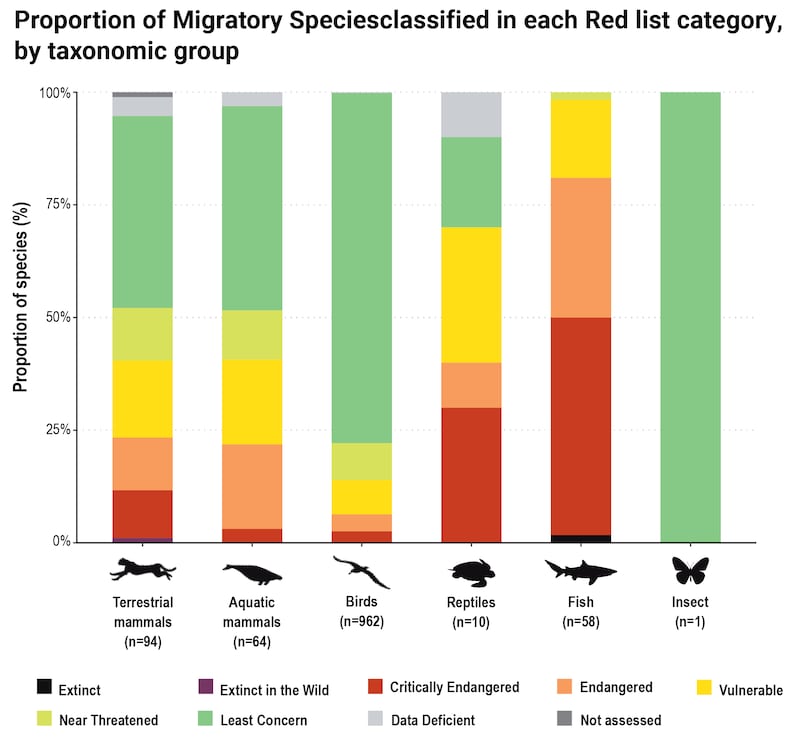More than a fifth of the Earth’s migratory species under international protection are threatened with extinction, according to a United Nations assessment.
Most worryingly, nearly all listed species of fish – including migratory sharks, rays and sturgeons – “are facing a high risk of extinction, with their populations declining by 90 per cent since the 1970s”, it warns.
Billions of animals journey with the seasons over oceans, on land and in the skies, but the Convention on the Conservation of Migratory Species of Wild Animals (CMS), a UN biodiversity treaty, has found many protected migratory species are at risk of disappearing, threatened by human pollution, the spread of invasive species and the climate crisis.
Many of the ecosystems where they migrate to and live temporarily are not adequately protected, the report published on Monday finds. The report is the first on the state of the world’s migratory species.
The assessment of animals protected under the treaty found 22 per cent of the 1,189 CMS-listed species are threatened with extinction and nearly half (44 per cent), are showing population declines, with many under unsustainable pressure from habitat loss and overexploitation.
Globally, 399 migratory species threatened or near threatened with extinction are not currently listed under the CMS.
Over the past 30 years, 70 CMS-listed migratory species – including the steppe eagle, Egyptian vulture and the wild camel – have become more endangered. This contrasts with just 14 listed species that now have an improved conservation status, including blue and humpback whales, the white-tailed sea eagle and the black-faced spoonbill.

Migratory species play an essential role in maintaining ecosystems, and provide vital benefits by pollinating plants, transporting key nutrients, preying on pests and helping to store carbon.
Until now, no such comprehensive assessment on migratory species has been carried out. It provides the latest information on their main threats and successful actions to save them.
Executive director of UN Environment Programme Inger Andersen said: “Today’s report clearly shows us unsustainable human activities are jeopardising the future of migratory species – creatures who not only act as indicators of environmental change but play an integral role in maintaining the function and resilience of our planet’s complex ecosystems.
“The global community has an opportunity to translate this latest science of the pressures facing migratory species into concrete conservation action. Given the precarious situation of many of these animals, we cannot afford to delay,” she added.
CMS executive secretary Amy Fraenkel said: “When species cross national borders, their survival depends on the efforts of all countries in which they are found. This landmark report will help underpin much-needed policy actions to ensure that migratory species continue to thrive around the world.”
The two greatest threats to both CMS-listed and all migratory species were confirmed as overexploitation – which includes unsustainable hunting, overfishing and capture of non-target animals such as in fisheries – and habitat loss, degradation and fragmentation – from activities such as agriculture and expansion of transport and energy infrastructure.
A key priority is to map and take adequate steps to protect vital locations that serve as breeding, feeding and stopover sites for migratory species, the assessment says.
It found 399 migratory species – mainly birds and fish, including many albatrosses and perching birds, ground sharks and stingrays – are categorised as threatened or near-threatened but are not yet CMS-listed.
Its recommendations include:
- Strengthen and expand efforts to tackle illegal and unsustainable taking of migratory species, as well as incidental capture of non-target species;
- Increase actions to identify, protect, connect and effectively manage important sites for migratory species;
- Urgently address those species in most danger of extinction, including nearly all CMS-listed fish species;
- Scale up efforts to tackle climate change, as well as light, noise, chemical and plastic pollution;
- Consider expanding CMS listings to include more at-risk migratory species in need of national and international attention.





